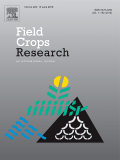Ver ítem
- xmlui.general.dspace_homeCentros Regionales y EEAsCentro Regional Salta - JujuyEEA Abra PampaArtículos científicosxmlui.ArtifactBrowser.ItemViewer.trail
- Inicio
- Centros Regionales y EEAs
- Centro Regional Salta - Jujuy
- EEA Abra Pampa
- Artículos científicos
- Ver ítem
Multi-environmental evaluation for grain yield and its physiological determinants of quinoa genotypes across Northwest Argentina
Resumen
The quinoa growing region of Northwest Argentina (NWA) shows a strong environmental variability, both
seasonal and spatial. In consequence, the site-year combinations in which yield trials are established can
complicate quinoa genotypic selection through strong genotype-by-environment interactions (G
E).
The magnitude and nature of the genotype (G) and G
E interaction effects for grain yield, its
physiological determinants and components, and
[ver mas...]
The quinoa growing region of Northwest Argentina (NWA) shows a strong environmental variability, both
seasonal and spatial. In consequence, the site-year combinations in which yield trials are established can
complicate quinoa genotypic selection through strong genotype-by-environment interactions (G
E).
The magnitude and nature of the genotype (G) and G
E interaction effects for grain yield, its
physiological determinants and components, and days-to-flower exhibited by quinoa at NWA were
examined in a multi-environment trial involving a reference set of 12 genotypes tested in six
environments. The tested genotypes were selected based on their known contrasting relative
performance to environments and different geographical origin. They represent three out of the four
genotypic groups identified in previous studies. The G
E interaction to G component of variance was 3:1,
30:1 and 1.3:1 for grain yield, harvest index and grain number, respectively. Conversely, the G effect was
large for biomass, grain weight and days-to-flower. Two-mode pattern analysis of the double-centered
matrix for grain yield revealed four genotypic groups with different response pattern across
environments. This clustering which separates genotypes from highlands and valleys showed a close
correspondence with the genotypic groups previously proposed based on phenotypic and genetic
characterization. On the other hand, a strong and repeatable negative association was observed between
highland and valley sites, in terms of their G
E interaction effects. Phenological variation among
genotypes in combination with environmental differences in the incidence of mildew or frost risk gave
rise to significant crossover yield responses to site changes and determined specific adaptation to
different ecological conditions. All yield components and determinants were involved in the genotype-
specific yield responses. The genotypic variability observed for time to
flowering determined the form of
the G
E interactions observed for total above-ground biomass in valley environments, while in the
highland sites, harvest index made a significant contribution. On the other hand, grain number was the
major component in grain yield determination, while grain weight showed a weak to strongly negative
association with grain number across both types of environment. In this sense, the future breeding
programs in NWA region should focus on these physiological attributes underlying grain yield variation
among genotypes across groups of environments for faster genetic progress.
[Cerrar]

Autor
Curti, Ramiro Nestor;
Vega, Abelardo J. de la;
Andrade, Alberto Juan;
Bramardi, Sergio Jorge;
Bertero, Héctor Daniel;
Fuente
Field crops research 166 : 46–57. (2014)
Fecha
2014
ISSN
0378-4290
Formato
pdf
Tipo de documento
artículo
Palabras Claves
Derechos de acceso
Restringido
 Excepto donde se diga explicitamente, este item se publica bajo la siguiente descripción: Creative Commons Attribution-NonCommercial-ShareAlike 2.5 Unported (CC BY-NC-SA 2.5)
Excepto donde se diga explicitamente, este item se publica bajo la siguiente descripción: Creative Commons Attribution-NonCommercial-ShareAlike 2.5 Unported (CC BY-NC-SA 2.5)

